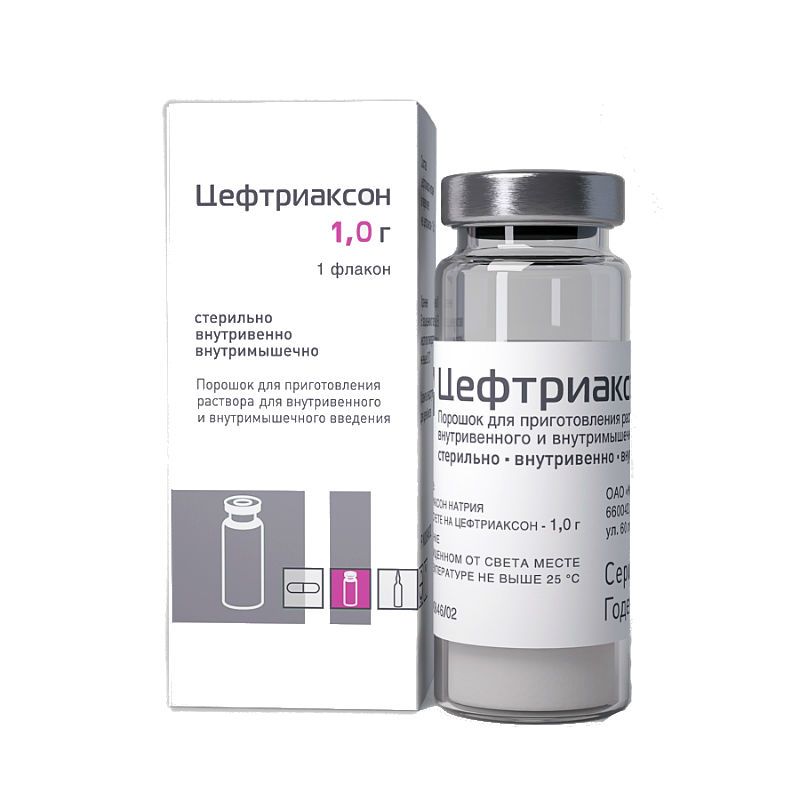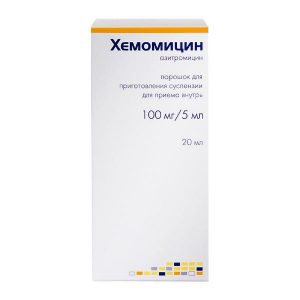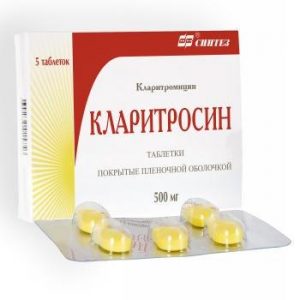Description
Latin name
Ceftriaxone
Release form
Powder for solution for injection for injection
Packing
50 pcs
Pharmacological action
Ceftriaxone is a third-generation cephalosporin broad-spectrum antibiotic. It is bactericidal, inhibiting the synthesis of the cell membrane of microorganisms. In vitro inhibits the growth of most gram-positive and gram-negative bacteria. Resistant to b-lactamases.
It is active against gram-positive aerobic bacteria: Staphylococcus aureus, Staphylococcus epidermidis, Streptococcus pneumoniae, Streptococcus pyogenes, Streptococcus agalactiae, Streptococcus viridans, Streptococcus bovis gram-negative aerobic bacteria, bacteromera aeroma. , Citrobacter spp., Enterobacter spp., (Some strains are resistant), Escherichia coli, Haemophilus ducreyi, Haemophilus influenzae (including penicillinase producing strains), Haemophilus parainfluenzae, Klebsiella spp. (including Klebsiella pneumoniae), Moraxella spp., Morganella morganii, Neisseria gonorrhoeae (including penicillinase producing strains), Neisseria meningitidis, Plesiomonas shigelloides, Proteus mirabilis, Proteus vulgaris, Providencia spp., Salmonella spp. (including Salmonella typhi), Serratia spp. (including Serratia marsescens), Shigella spp., Vibrio spp. (including Vibrio cholerae), Yersinia spp. (including Yersinia enterocolitica), Pseudomonas aeruginosa (some strains) of anaerobic bacteria: Bacteroides spp. (including some strains of Bacteroides fragilis), Clostridium spp. (except Clostridium difficile), Fusobacterium spp. (except Fusobacterium mortiferum and Fusobacterium varium), Peptococcus spp., Peptostreptococcus spp.
Methicillin-resistant strains of Staphylococcus spp., Enterococcus spp., Bacteroides fragilis (strains producing b-lactamases) are resistant to the drug.
Indications
Infectious-inflammatory diseases caused by microorganisms sensitive to ceftriaxone, including peritonitis, sepsis, meningitis, cholangitis, empyema of the gallbladder, shigellosis, salmonella carriage, pneumonia, lung abscess, pleural empyema, pyelonephritis, infections of bones, joints, skin and soft tissues, genitals, infected wounds and burns.
Prevention of postoperative infection.
Contraindications
Hypersensitivity to ceftriaxone pregnancy (I trimester).
Special instructions
Cautiously prescribe the drug to newborns (including premature) children due to the high risk of developing hyperbilirubinemia, with ulcerative colitis.
With simultaneous severe renal and hepatic insufficiency, the plasma concentration of the drug should be regularly determined.
With prolonged treatment, it is necessary to regularly monitor the picture of peripheral blood, indicators of the functional state of plasma and kidneys.
In rare cases, with ultrasound of the gallbladder, blackouts are noted that disappear after cancellation (even if this phenomenon is accompanied by pain in the right hypochondrium, it is recommended to continue prescribing an antibiotic and carrying out symptomatic treatment).
Dosage and administration
Ceftriaxone is given in / m or in / in (stream or drip).
For adults and children over 12 years old, the average daily dose is 1-2 g of ceftriaxone 1 time / day.
In severe cases or in cases of infections caused by moderately susceptible pathogens, the daily dose can be increased to 4 g (2 g 2 times / day).
For newborns (up to two weeks of age), the dose is 20-50 mg / kg / day.
For infants and children up to 12 years old, the daily dose is 20-80 mg / kg.
In children weighing 50 kg or more, adult doses are used.
A dose of more than 50 mg / kg body weight should be given as an iv infusion (drip). The duration of treatment depends on the nature of the disease.
With bacterial meningitis in infants and young children, the initial dose is 100 mg / kg 1 time / day. The maximum daily dose is 4 g.
For the treatment of acute gonorrhea, the dose is 250 mg, once a / m.
To prevent infections in the preoperative and postoperative periods 30-90 minutes before surgery, 1-2 g of ceftriaxone are administered.
In case of renal failure (creatinine clearance less than 10 ml / min), the daily dose of ceftriaxone should not exceed 2 g.
In case of severe impairment of liver and kidney function, as well as in patients on hemodialysis, it is necessary to monitor the concentration of ceftriaxone in blood plasma, t .to. they may decrease the rate of its release.
Side effects
Allergic reactions: about 1% – urticaria, fever, chills, eosinophilia, rash, itching, exanthema, allergic dermatitis, exudative erythema multiforme, edema, anaphylactic shock.
From the digestive system: nausea, vomiting, stomatitis, glossitis, diarrhea, pseudomembranous enterocolitis, cholestasis, increased activity of hepatic transaminases, hyperazotemia, hypercreatininemia, increased urea.
From the side of the central nervous system: headache, dizziness.
From the hemopoietic system: leukopenia, neutropenia, granulocytopenia, thrombocytopenia, hemolytic anemia.
Local reactions: with iv administration – phlebitis, soreness along the vein, with iv administration – soreness at the injection site.
Other: superinfection (including candidomycosis, genital mycosis) oliguria, hypocoagulation.
Drug Interactions
Ceftriaxone and aminoglycosides have synergies with many gram-negative bacteria.
Possible simultaneous administration with metronidazole, fluoroquinolones, vancomycin, rifampicin (but not in the same syringe).
When used simultaneously with loop diuretics (for example, furosemide), renal dysfunction is not observed.
Pharmaceutical Interactions
Pharmaceutically incompatible with solutions containing other antibiotics.
Overdose
Treatment: symptomatic. Hemodialysis and peritoneal dialysis are not effective.
Storage Conditions
Store in a dry, dark place at 15-25 ° C.
Shelf life
2 years.
Active ingredient
Ceftriaxone
Pharmacy conditions
prescription
Indications
Indications
Pyelonephritis, Skin infections, Pneumonia, Sepsis, Cystitis, Skin infections, Vaginal infections




